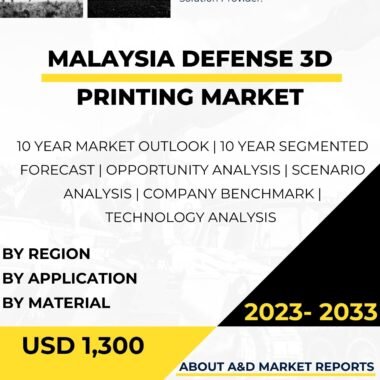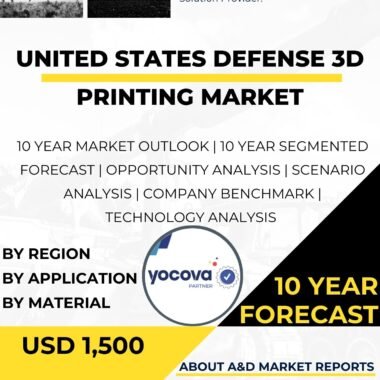Description
The Australia Defense 3D Printing Market is a rapidly emerging and transformative sector that is revolutionizing the way the Australian Defense Force (ADF) designs, manufactures, and maintains critical components and equipment. Also known as additive manufacturing, 3D printing allows for the creation of complex and customized objects by building layer upon layer of materials. This technology enables the ADF to reduce lead times, enhance supply chain efficiency, and improve equipment performance while also contributing to cost savings. The Australia Defense 3D Printing Market has gained significant momentum due to the increasing demand for innovative and cost-effective solutions to address defense challenges, ranging from spare parts production to on-demand manufacturing of specialized tools and equipment. This article provides a comprehensive analysis of the Australia Defense 3D Printing Market, covering its current state, key drivers, challenges, applications, technological advancements, and growth prospects.
The Australia Defense 3D Printing Market has experienced notable growth due to the numerous advantages it offers to the ADF. One of the key drivers behind its prominence is the ability to produce highly customized and complex components on-demand. 3D printing allows the ADF to design and manufacture specialized parts tailored to specific needs, such as replacement components for aging equipment or unique components for niche applications. This capability not only streamlines the supply chain but also reduces the dependency on external vendors and increases operational readiness.
Moreover, the Australia Defense 3D Printing Market is driven by the potential cost savings associated with additive manufacturing. Traditional manufacturing processes often involve high costs for tooling and setup, especially for low-volume or one-off production. 3D printing eliminates the need for expensive tooling, reducing production costs for small-batch manufacturing and prototypes. It also enables the ADF to repair and replace components in the field, reducing downtime and extending the lifespan of existing equipment.
Additionally, the market’s growth is influenced by Australia’s focus on fostering technological innovation within its defense industry. Embracing 3D printing allows the ADF to stay at the forefront of technology and leverage the capabilities of advanced materials to improve the performance and functionality of its equipment. Collaborations between the government, defense industries, and research institutions have played a crucial role in advancing additive manufacturing technology and creating opportunities for local businesses.
The Australia Defense 3D Printing Market encompasses a diverse range of applications across various domains within the defense sector. One significant application is in the production of spare parts and components. Aging defense systems often face challenges in sourcing spare parts due to obsolescence or limited availability from traditional suppliers. 3D printing enables the ADF to produce these parts in-house, reducing dependency on external suppliers and ensuring the availability of critical components when needed.
Furthermore, 3D printing is employed in the development of prototypes and proof-of-concept models. This application allows the ADF to rapidly iterate and test new designs, leading to faster development cycles and more efficient design processes. The ability to create prototypes quickly and cost-effectively accelerates innovation and allows the ADF to explore various design alternatives before committing to large-scale production.
Moreover, the Australia Defense 3D Printing Market finds applications in producing specialized equipment and tools. Additive manufacturing enables the creation of unique and mission-specific tools, such as jigs, fixtures, and deployment aids. These custom tools enhance the ADF’s operational capabilities, facilitating more efficient and effective operations in the field.
In addition to component production, 3D printing is used in the creation of wearable technology and personal protective equipment (PPE). The ADF can manufacture custom-fit gear, such as helmets and body armor, for individual soldiers, improving comfort and mobility while ensuring superior protection.
Despite the market’s growth and potential, the Australia Defense 3D Printing Market also faces certain challenges. One significant challenge is the need for continuous research and development to maximize the benefits of additive manufacturing in defense applications. As 3D printing technology evolves, the ADF must stay abreast of advancements to capitalize on new materials, techniques, and capabilities.
Moreover, addressing the issue of regulatory compliance and certification is essential to ensure the safety and reliability of 3D-printed components. Certain defense applications require strict adherence to standards and certifications to guarantee the performance and integrity of printed parts under different operational conditions.
Additionally, promoting the adoption of 3D printing across the defense industry requires awareness and training initiatives. Educating key stakeholders on the benefits and potential of additive manufacturing is vital to encouraging its widespread use and integration into defense operations.
Looking ahead, the Australia Defense 3D Printing Market is expected to witness continued growth and advancements. As the ADF continues to prioritize innovation and modernization, the demand for 3D-printed components and equipment will remain strong. Continued investment in research and development, collaboration between the government and industry stakeholders, and a focus on addressing technical challenges will drive advancements in additive manufacturing technology and its applications in the defense sector.
In conclusion, the Australia Defense 3D Printing Market is a strategically important and transformative sector that is revolutionizing the country’s defense industry. 3D printing enables the ADF to produce highly customized components, reduce lead times, and achieve cost savings in manufacturing and supply chain operations. The market’s growth is driven by the demand for innovative and cost-effective solutions, technological innovation, and the ability to create on-demand, mission-specific equipment. Addressing challenges related to technology advancement, regulatory compliance, and promoting adoption will be crucial to unlocking the full potential of the Australia Defense 3D Printing Market and supporting the ADF’s modernization efforts for the future.




